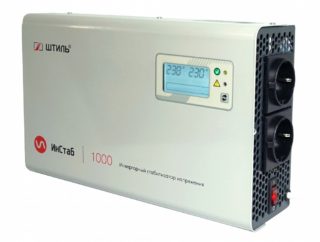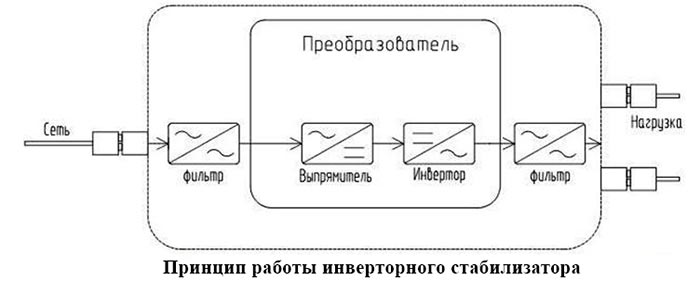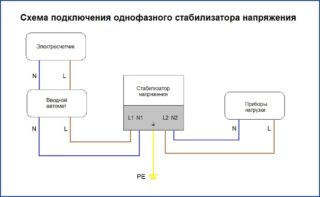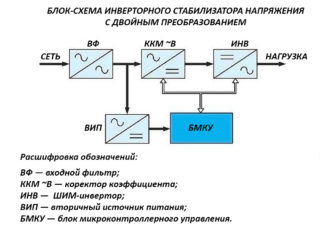The market is oversaturated with an abundance of voltage rectifiers represented by dozens of world brands. Each of them differs in the type of nutrition, functionality and the principle of stabilization. Due to such a variety of devices, users do not know which model to choose. The most effective is an inverter voltage regulator, popularly referred to as a double conversion normalizer.
Internal structure

An inverter stabilizer is an automatic mains voltage regulator capable of transmitting current with the same frequency and constant voltage indicator, with a deviation of no more than 0.5% from the normalized value.
Inverter rectifiers are considered the best on the market for a reason. They stand out for their principle of operation, based on a different structure than electronic normalizers. The output voltage always shows the same value.
A classic inverter consists of the following elements:
- input filters - designation ВХ;
- rectifier and power factor corrector - V and KKM;
- capacitor block - VIP;
- DC-to-AC voltage conversion devices - INV;
- microcontroller - MK.
Some elements of this circuit, such as a rectifier and a current converter, also refer to stabilizers based on the IGBT transistor group. In their structure, bipolar transistors with an insulated gate type are integrated. The second feature is the presence of a metal oxide conductor of the Mosfet model.
Principle of operation
The double rectifier performs only 2 key functions during operation:
- converts alternating current to direct current;
- the second function is reversible - it converts DC type current into AC type.
The first stage of operation includes devices such as a power factor corrector and a direct rectifier. Simply put, AC current is unstable and enters the equipment through a filter that rectifies it and makes it constant. Frequencies can also be filtered. After such manipulations, the current takes on a virtually perfect sinusoidal shape.
The advantage is that in this situation, the power indicators are significantly increased. The power factor ratio reaches literally 1.0. After the filter is passed, the current is accumulated in the capacitor unit - the secondary power supply.
Further, inverter normalizers operate according to the following principle: direct current, which has been rectified and converted, moves to the inverter, whose task is to convert it into alternating current and form the same sinusoid. Under the influence of the inverter, the AC current acquires a voltage indicator of 220 V and a frequency of 50 Hz.
Features of inverter stabilizers
Inverter voltage stabilizers for home are significantly different from electromechanical and relay types. The key difference is the lack of an automatic transformer. The double conversion procedure can also be compared with switching the winding of transformers in other types of normalizers.The two-stage conversion process is much more efficient, as a result of which inverters are considered to be the most advanced among other devices.
Each voltage surge that is likely at the input to the normalizer is leveled by a capacitor. Energy is accumulated in this component, and then it is transmitted in the form of an alternating current.
Benefits
An inverter stabilizer has a lot of advantages in comparison with other types of devices. The main ones are:
- functioning in a wide range of input voltage - 115-300 V;
- voltage stability is maintained constantly;
- noiseless functioning;
- dimensions and weight of inverter equipment are significantly lower, which is facilitated by the absence of an automatic transformer;
- high-frequency emissions and any interference are filtered by the device;
- high efficiency factor - from 90%;
- speed of regulation of input and output current.
The advantages of the stabilizer are very weighty. It is simply impossible to meet them all on devices of a different type.
disadvantages
Despite the many advantages, even a single-phase stabilizer has its own disadvantages. The main one is the high price. Another disadvantage is that inverter devices lower the input voltage range. The more power of devices connected to the network through the normalizer, the smaller this range becomes.
Operating conditions
Inverter rectifiers are quite unpretentious in operation. This is best expressed in characteristics such as resistance to ambient temperature and high humidity. Almost all models of these devices operate without problems in temperatures ranging from -40 / + 40 degrees. The maximum moisture content is 95%.
However, when the stabilizer is turned on, it should not be exposed to water and various types of lubricants. Their direct penetration into the device will render it unusable. Even the slightest condensation inside can damage the rectifier.
Connection features
Before connecting the device, you must disconnect the entire home network. The rectifier can be connected both in front of specific devices and immediately behind the meter.
Many inverter models are connected to the network via terminals. First, the input wiring is connected, which will carry the current. To do this, it is required to establish in the power panel which cable is "zero" and which "phase". Also, do not forget about grounding.
The wire with "phase" is connected to the terminal - designation L or L1. The wire with "zero" is connected to the zero terminal. The cross-section of the input wiring must be at least 2.5 mm.
Criterias of choice
When choosing an inverter-type rectifier, you need to be guided by the following characteristics:
- device power;
- level of permissible load;
- fast voltage equalization;
- output voltage form;
- the accuracy of the specified parameters;
- value of permissible fluctuations;
- operating conditions.
Power is the most important selection criterion for a stabilizer. These characteristics of the device are selected in accordance with the factor how many consumers will be connected to it - one apartment or the entire apartment building.
It is necessary to carefully calculate the entire potential load on the rectifier. To the obtained value, add 25% of the power for the reserve so that the device does not experience the maximum load.
Double Conversion Inverter Regulators
- Devices carry out the conversion of DC type voltage to AC type. They are produced using IGBT or Mosfet semiconductor elements, which are installed on radiators.
- The rectifier can be controlled by a PWM controller.
- Double-conversion devices have a good level of protection against significant mains voltage surges.
- A special microcontroller controls the functions of the device.
- The stabilizer is equipped with a quartz oscillator, which guarantees a high-quality output current.
Thanks to new technical solutions, home inverters make it possible to obtain a voltage at the output with a nominal value, the maximum deviation of which does not exceed 1%. Inverter-type stabilizers are the only device that strictly controls the frequency indicator.











